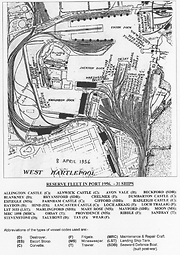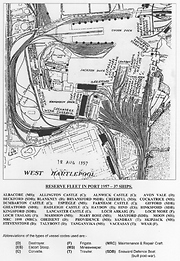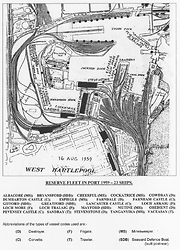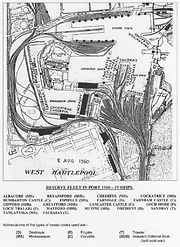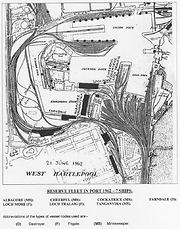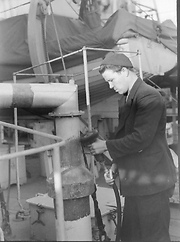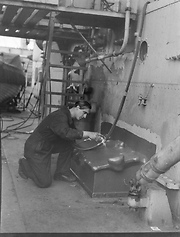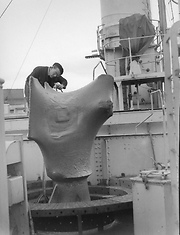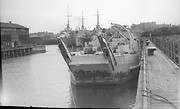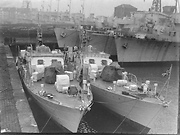 Hartlepool Sports & Leisure
Hartlepool Sports & Leisure
- Cinemas, Theatres & Dance Halls
- Musicians & Bands
- At the Seaside
- Parks & Gardens
- Caravans & Camping
- Sport
 Hartlepool Transport
Hartlepool Transport
- Airfields & Aircraft
- Railways
- Buses & Commercial Vehicles
- Cars & Motorbikes
- The Ferry
- Horse drawn vehicles
 A Potted History Of Hartlepool
A Potted History Of Hartlepool
- Unidentified images
- Sources of information
- Archaeology & Ancient History
- Local Government
- Printed Notices & Papers
- Aerial Photographs
- Events, Visitors & VIPs
 Hartlepool Trade & Industry
Hartlepool Trade & Industry
- Trade Fairs
- Local businesses
- Iron & Steel
- Shops & Shopping
- Fishing industry
- Farming & Rural Landscape
- Pubs, Clubs & Hotels
 Hartlepool Health & Education
Hartlepool Health & Education
- Schools & Colleges
- Hospitals & Workhouses
- Public Health & Utilities
- Ambulance Service
- Police Services
- Fire Services
 Hartlepool People
Hartlepool People
 Hartlepool Places
Hartlepool Places
 Hartlepool at War
Hartlepool at War
 Hartlepool Ships & Shipping
Hartlepool Ships & Shipping

The Reserve (Mothball) Fleet
Details about The Reserve (Mothball) Fleet
Royal Navy ships laid-up at Hartlepool after WW2, prior to their disposal, and referred to locally as the 'Mothball Fleet'.
Location
Related items :
 Admiral Crombie visiting Mothball Fleet
Admiral Crombie visiting Mothball Fleet
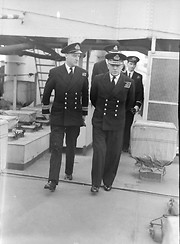 Created by NDM
Donated by Hartlepool Museum Service
Created by NDM
Donated by Hartlepool Museum ServiceAdmiral Crombie visited the Royal Navy Reserve Ships in Hartlepool Docks and is possibly here on Loch Arkaig which was the HQ vessel. This will have been circa 1954.
More detail » Alice in Union Dock
Alice in Union Dock
 Created by NDM
Donated by Hartlepool Museum Service
Created by NDM
Donated by Hartlepool Museum ServiceTaken around 1954, this is Alice on B jetty Middleton Road in the Union Dock. The mothball fleet vessel in the background is M383 Tanganyika, an Algerine type minesweeper and next to her probably a similar vessel Albacore of the same class.
More detail » Civic Reception for the Admiral
Civic Reception for the Admiral
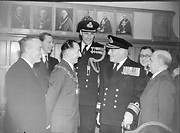 Created by Northern Daily Mail
Donated by Hartlepool Museum Service
Created by Northern Daily Mail
Donated by Hartlepool Museum ServiceAdmiral Crombie and others meeting the Mayor in the Civic Buildings.
More detail » H.M.S.Chailey (2)
H.M.S.Chailey (2)
 Created by Northern Daily Mail
Donated by Hartlepool Museum Service
Created by Northern Daily Mail
Donated by Hartlepool Museum ServiceThe Inshore Minesweeper M 2009 HMS CHAILEY coming up the entrance channel into Hartlepool. Following her is another (unidentified) minesweeper destined for lay-up in Hartlepool.
More detail » Inspecting the Fleet
Inspecting the Fleet
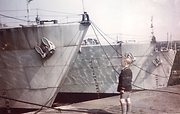 Donated by David Proud
Donated by David ProudDated 1959
Jamie Proud inspects the mothballed destroyers in Hartlepool Docks in the late 1950s.
More detail » Meeting the Admiral
Meeting the Admiral
 Created by Northern Daily Mail
Donated by Hartlepool Museum Service
Created by Northern Daily Mail
Donated by Hartlepool Museum ServiceA group of sailors, who maintained the fleet, are lined up to meet Fleet Admiral Crombie on board the head quarters vessel, the frigate LOCH ARKAIG.
More detail » Mothball Fleet
Mothball Fleet
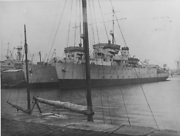 Created by Cleveland Planning Dept.
Donated by Hartlepool Museum Service
Created by Cleveland Planning Dept.
Donated by Hartlepool Museum ServiceThe Mothball Fleet in the Coal Dock
More detail » Mothball Fleet six ships in Coal Dock
Mothball Fleet six ships in Coal Dock
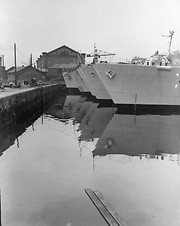 Created by NDM
Donated by Hartlepool Museum Service
Created by NDM
Donated by Hartlepool Museum ServiceMothball Fleet in coal dock. Warehouse in background. In order from nearest HMS Lancaster, Dumbarton, Hadleigh, Farnham, Alnwick, and Allington. Around 1954
More detail » Personal memories of the Mothball Fleet
Personal memories of the Mothball Fleet
This article, written by Dave Wright, appeared in ‘Tees Packet’ No.172, November 2007:
PERSONAL MEMORIES OF THE RESERVE FLEET - By Dave Wright.
I served for almost 24 years, from 1953 until 1977, in the Royal Navy’s Supply and Secretariat branch, specialising in naval storekeeping and accounting. It was in 1958 that I was attached to the Reserve Fleet after I had returned from witnessing three nuclear tests in the carrier H.M.S. WARRIOR based at Christmas Island in the Pacific.
The introduction of nuclear bombs and guided missile systems rendered a large percentage of naval ships incapable of defence against these new weapons and many of the older ships became obsolete almost overnight. It was these ships of every category from aircraft carrier to MTB that formed the Reserve Fleet which was laid up around the country and naval bases abroad. The ships in reserve were put into different categories depending on their age and any foreseeable use in times of emergency. The eldest ships, those built in, or at the end of WW1 soon went to the breakers yards. The remainder were then laid up after specialised methods of preservation had been undertaken. A lot were modernised before being laid up. The 1950’s and early 1960’s saw hundreds of wartime ships downgraded in category which led to their ultimate scrapping and this helped clear many civilian ports where they had been held. The new generation of ships held in reserve were modernised, and post war ones which were unable to be manned because of the reduction in the size of the Royal Navy and manpower shortages. Many newly built ‘Ton’ class of minesweeper went straight into reserve.
The theory behind the Reserve Fleet was that laid up ships could be brought forward and commissioned at very short notice in case of emergency. To this purpose they were equipped with sufficient spares to save time storing the ship when it was needed. Obviously not everything required was placed on board. It was impractical to store things like ammunition and food, and other perishable commodities on laid up vessels, but sufficient ‘dormant’ stocks of this sort of thing were held ashore to be called forward when required. It was against this background that I found myself attached to the Reserve Fleet at Chatham in March 1958. I was to spend three years altogether working with the ships in reserve. I was initially lent to the ‘Algerine’ class minesweeper H.M.S. MUTINE undergoing refit and trials at the naval dockyard at Sheerness. Following that I spent a year at the Reserve Fleet outstation at Hartlepool where we were employed stripping the downgraded ships of stores and equipment before they went to the breakers. Many of these were ‘Algerine’ minesweepers. Finally I was part of the Stand-by crew to commission the Type 15 frigate H.M.S. RELENTLESS if required at Chatham and ultimately at Rosyth.
H.M.S. NEPTUNE was the name given to the Reserve Fleet at Chatham. The accommodation ships were the DUNCANSBY HEAD and MULL OF GALLOWAY, both being Maintenance and Repair Ships built in Canada, and they were berthed in the corner of No.2 basin. The reserve ships were laid up around the dockyard, but nowhere near the quantity at Portsmouth. The shore-side offices, for their stores staff was the Bull’s Nose – near the entrance locks to the dockyard. After only a few weeks I was sent on loan to H.M.S. WILDFIRE, the base in the dockyard at Sheerness on the Isle of Sheppey. The purpose was to stand by the ‘Algerine’ class minesweeper MUTINE which, although in reserve, was undergoing a minor refit to update her. Having completed the refit we undertook 2 or 3 days sea trials, and then preserved the ship for laying up. WILDFIRE was just one barrock block in the dockyard, and the yard as I recall it was not very large at all. A small tidal basin, with a couple of dry-docks. It was home to the Inshore Survey Squadron – 4 or 5 Motor Launches whose job it was to survey and chart the areas around the Thames estuary. Across the mouth of the River Medway was the Isle of Grain, with its large oil terminal; and visible from the dockyard were the masts of a sunken ammunition ship lying on the sea bottom. Rumour had it that the wreck was considered too dangerous to salvage, and as far as I know she still lies there to this day.
Sheerness was a pleasant little dockyard in which to work, but there was not an awful lot to do ashore. After two months there, my job completed, I returned to Chatham. Back at the Bull’s Nose the situation was similar to my early days in Portsmouth; there did not appear to be a lot happening and I spent 2 or 3 months odd jobbing.
Before joining the navy, and on leave from the navy, my brothers and I had followed motor-cycle scrambling. I had learned to ride, and had passed my test, so when I saw a new Greeves trials bike for sale in Chatham I obtained it on hire-purchase, and continued supporting scrambles, grass track events and trials riding, either in Kent, or at home, whenever I could. Scooters were very popular at this time as well, and together with a couple of other chaps, we used to venture as far as Margate and Ramsgate in the evenings for a night ashore. In one of those towns Butlin’s had an hotel, with an ex-Wren working behind the bar, where we always managed to get 3 pints for the price of one; so passed the early summer months of 1958.
In June, I cannot remember the exact date, I left Chatham to go to a sub-division of NEPTUNE, the Reserve Fleet at West Hartlepool. There must have been at least 2 dozen ships laid up there, with the headquarters ship being LOCH TRALAIG; the ships were mostly ‘Loch’ and ‘Bay’ class frigates, destroyers (mainly ‘Hunt’ class), ‘Algerine’ class minesweepers and the odd dan-laying trawler. Each ship was laid up fully stored (apart from food), and supposedly capable of being commissioned in 10 to 14 days. However, the policy regarding reserve ships had recently been reviewed, and older and un-modified classes were now to be disposed of; this is where I came in – I was one of a party of 5 Jack Dusties whose job it was to de-store each ship in turn, before it was sold to the breaker’s yard.
The LOCH TRALAIG was the headquarters ship, but she was not a living ship, and if you were not local and lived with your family, you were accommodated in one of two boarding houses, 2 miles along the front at Seaton Carew was the Seaton Hotel, but I was billeted at 21 Thornton Street in the town itself. On pay day we were each given an extra 30 shillings subsistence allowance as we did not get a meal at lunchtime; in fact, our landlady gave us a packet of sandwiches daily – so our allowance was used as beer money. What started out as temporary employment was to finish up lasting a full year. I lost count of the number and names of the ships we worked on, but on average each job took us 3 weeks, so 15 ships at 3 weeks each equals 45 weeks, plus 3 leave periods of a fortnight each would account for that year. We would set ourselves up in a convenient small mess, together with an electric kettle and materials for a brew, and systematically empty the ship, compartment by compartment, of everything that was not screwed or wired into place. Every item had to be tallied, small items boxed, or packed in hampers and the relevant paperwork raised. Everything was then taken ashore to be placed in either box or open railway trucks, and eventually onward shipment to the stores depots and dockyards. I particularly remember the minesweepers required that bit more effort because they carried so much steel wire rope, wire cutters, dan-buoys and sinkers, and equipment for towing astern. It was always a pleasure to complete a job on a minesweeper.
On my 22nd birthday in April ’59 I had completed 4 years man’s service and I was awarded my first good conduct badge, which entitled me to an extra 4 pence a day. As I mentioned, I was there for a year; the summer months were not too bad – but in winter, with a bitter wind coming off the northeast coast, and working on a dead ship, it was a different picture altogether. I well remember one period, there was no snow, but ice was forming on Swainson Dock, which was a salt water dock. I enjoyed my time in what is now known as the Hartlepool’s – West and Old – and soon learned not to mention the ‘Monkey’. The story tells of a great storm, many years ago, when a French ship was wrecked off the north-east coast. The only thing to survive was the ship’s pet monkey, which was washed up at Old Hartlepool. Because it was dressed in a specially made matelot’s uniform, the monkey was arrested, tried as a spy, and was hanged by the locals; so you should not ask the question “Who hung the monkey?” when in Hartlepool.
The docks still provided a lot of work in the town, Gray’s ship-builders had a ship on the stocks, which was launched while I was there; the coal staithes were always busy loading colliers with locally produced coal; Russian and Scandinavian boats were continually unloading cargoes of pit-props; and Old Hartlepool had its fishing boats. Away from the docks, but before Seaton Carew, a new steelworks was being built, and several Irish labourers who worked there shared our digs. It wasn’t exactly a thriving town, but there was plenty of work available.
At lunch-times, and in the winter evenings, we would gather in the Volunteer Arms. It was on my first visit there, as a committed Southerner, I made the mistake of asking for a Brown and Mild – not realising that Mild beer doesn’t exist north of the Wash. What they did sell was Cameron’s Strongarm, brewed locally for the steel workers, and this was a powerful brew. In the summer months we would walk along the front to Seaton Carew, spend the evening supping ale and playing dominoes, before returning to our digs. As we walked along the front, if the tide was low, we would watch the ‘natives’ gathering sea-coal off the beach – the coal seams surfaced just off the coast, and small deposits of coal were always being deposited by the incoming tide. I had taken my motor bike up with me, and at week-ends I would be off to the North Yorkshire moors following scrambling or trials. It was a good life in the North East; we worked hard, but we had good digs, good food and a good social life among honest and friendly people. So it was with a certain amount of sadness that I returned to Chatham and NEPTUNE; and it was soon after I got back to Chatham that some thieving dockyard matey stole my motor bike in order to build himself a go-kart, which were then all the rage.
This time I was to be given a full time job – I was designated as Category Crew for the RELENTLESS, a type 15 frigate. She was a wartime destroyer converted into a fast anti-submarine frigate, and as Cat-crew I would be required to commission her, should the need arise. The ship had all her stores in a lay-apart store in Old St Mary’s Barracks during the docking period, and we eventually replaced them all on board, and placed her in Operational Reserve, the highest reserve category. Two other members of the Hartlepool team had returned to Chatham as well, but they worked actually on the DUNCANSBY HEAD. But we were all in the same mess and we continued as run-ashore oppo’s. Evening runs could always be made into Chatham or the adjoining Medway towns; there was always the NAAFI club for accommodation, big eats and reasonably priced beer; whilst a favourite pub for a quiet evening was the Two Sawyers, just outside Gillingham Gate. Week-end runs wee often up to London, 40 minutes away to Victoria Station, where Saturday afternoon was spent at a football match – Chelsea or Fulham being favourite, as it was a better night on the town afterwards – with Sunday to recuperate before another run in the evening.
I think it was during 1957, whilst I was aboard on the WARRIOR, the S & S Training School moved from Wetherby into Chatham barracks, and they were now firmly established into local naval scene. But, far from building up, the Nore Command was destined to a steady decline over the next 2 decades, until the final inignomy when the Royal Navy finally left Chatham for good. In the meantime it had been announced that the Nore Command would cease from early 1961; the dockyard would continue, but RNB would be known as the Fleet Accommodation Centre. Part of the run down would be the transfer of the Reserve Fleet to other bases, and DUNCANSBY HEAD was towed away to Rosyth in May 1960. RELENTLESS followed suit, and we left Chatham under tow by BUSTLER, about 10 days later. There was a Cat-crew of about 10 on board for the tow which lasted about 5 days. The weather was glorious, and there wasn’t really a lot we could do whilst under toe. One diesel was flashed up to give us light and power for the officer’s galley, and with 10 days fresh provisions on board, I had some of the best meals I’d enjoyed since joining up. In mid May we arrived at Rosyth Dockyard, on the Firth of Forth in Scotland, where DUNCANSBY HEAD was already in her new berth on the South Arm. Closing down our home for the last week, the Cat-crew were soon established in our new messes on the DUNCS.
Times have changed and the Royal navy of to-day now consists of about the same number of operational ships as were laid up in Hartlepool some 50 years ago. The Reserve Fleet is now just a Standby Squadron, and it is even debatable as to whether there is sufficient manpower available to commission these ships if required.
More detail » Reserve Fleet Berths
Reserve Fleet Berths
A series of images showing the locations of the various ships of the Mothball Fleet in the 1950s and 1960s, compiled by Dr. Ian Buxton (Tees Packet No. 103), and revised by Derek Hinds.
More detail » Reserve Fleet Maintenance
Reserve Fleet Maintenance
A series of images showing various maintenance work being carried out on the Royal Navy's Reserve Fleet at West Hartlepool - known locally as the 'Mothball Fleet'.
More detail » Ships of the Reserve "Mothball" Fleet
Ships of the Reserve "Mothball" Fleet
Photographs of the various ships forming the Reserve, or "Mothball" Fleet, at West Hartlepool, in the 1950s and 1960s.
More detail » Sorlandet (2)
Sorlandet (2)
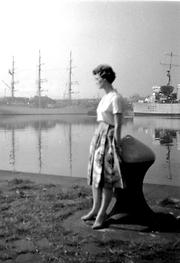 Created by John Robinson
Donated by John Robinson
Created by John Robinson
Donated by John RobinsonDated 1959
Ann Hutchinson at the coal on a sunny day in 1959. In the background is the Norwegian Sail traing ship Sorlandet, with one of the first of the 'Mothball Fleet' on the right.
More detail »




